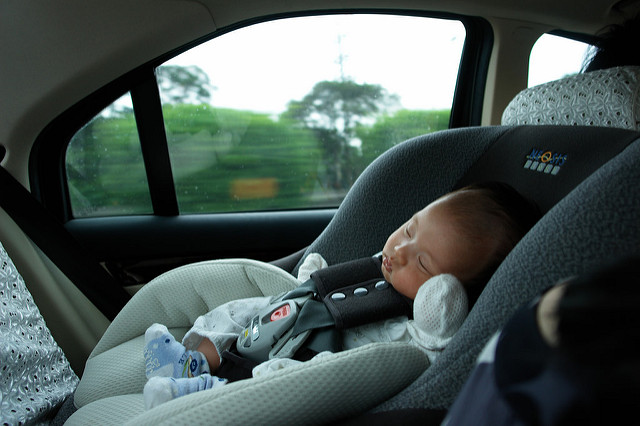Table of Contents
*This post may contain affiliate links. As an Amazon Associate we earn from qualifying purchases.
“Why do car seats have expiration dates?” Most of us have questioned the sanity of such a concept, and thought it was a clever ploy by manufacturers to assure as many sales as possible. It so happens there are many sound and sensible reasons for an expiration date to assure your child enjoys a safe ride every time.
Why Do Car Seats Expire: Know Car Seats and Their Laws
For safety and optimum quality, foods have expiration dates, and drugs and medications have expiration dates to prevent using weakening or other unsafe changes. Even shampoos and toothpaste have expiration dates.
Did you realize that children’s car seats have expiration dates, too? If you have been out of the baby business for several years, or are just getting to that phase of life, you may not have given this any thought, or even know that is the case.
Back in the 60’s a “car seat” was basically the equivalent of a plastic ice cream tub with wire coat hanger legs, that cost between $5 and $7 at the local five and dime. The plastic part was thin – you could see light through it. It was vented down the back to allow air circulation, though little good that did, because the seats were lined with a plastic covered foam pad “for comfort.”
There was a little handle cut out at the top for easy carrying, and a 1-inch wide plastic strap around the waist was supposed to keep the little one contained. An adjustable wire stand beneath the seat (which was just snapped into a couple of tabs, by the way) could sit your little one up or down in any of three or four positions.
The entire seat weighed about two pounds, could be rinsed in the tub, and was often seen being held together by masking or duct tape after being used for a couple of kids.
Not only were these seats lightweight, but they were also much less bulky than the seats of today, and would fit just about anywhere. People put them on the floor of the car, sideways on a seat, or in their lap.
Most people didn’t even bother to strap them to the seat, and they were usually placed up front by Daddy and Mommy, so the ride would not have to be interrupted if nursing, or diaper changing was necessary during the drive. Horrified yet?
Car seats have come a long way since then. Heavy molded plastic seats have multiple slots to fit seat belts through. The angle the baby sits at, is adjustable. The seats are padded an inch or so with thick and soft washable fabrics for optimum comfort and breathe-ability.
There are head rests and foot rests with cup holders. There are more generic brands and designer brands, and all come in a rainbow of colors. You can get units as one-piece dedicated car seats, or they detach from the base, and can be carried indoors or placed in a stroller. Those are a lot of great features, and they seem to be made well enough to last through a few kids, so why do car seats have expiration dates?
Who Needs to Understand Car Seat Expiration and Laws?
Anyone who is a parent, grandparent, babysitter, or another type of child caretaker needs to be aware of, and understand, car seat expiration dates and the laws that go with using them.
Are the expiration dates just a gimmick by a bunch of lobbyists forcing people to replace an expensive item for the benefit of the manufacturers? Truthfully, there are real and legitimate reasons why a car seat can become unsafe within a six-to-ten-year period.
Wear and Tear
The plastic base that straps the seat securely into the car can become cracked or fractured from being exposed to the heat and cold that goes with changes in the weather, parking in the sun, bumping into the sides of the car door, and a variety of other reasons. The base material can also shrink and dry out causing small fractures.
Straps are made of the same material as seat belts for strength and durability; however, with the frequency of being fastened and unfastened, buckles rubbing on them, and being tightened and repeatedly loosened, the clips can fail, leaving your baby to be hurled like a football through the car in the event of a crash. The straps can also become worn and frayed, and may even lose some of their rigidity over time.
Safety First

Image from: carseatsafetymatters
Continuous and repeated testing with crash-test dummies has revealed from time to time that in certain circumstances, different areas of a car seat may fail. An accident – even a minor one – can prove fatal to your little one if there is a design or material flaw.
Necessary Recalls
Occasionally through continued testing and development, a critical error in the design or materials may become evident. This will obligate the manufacturer to issue a recall for all seats sharing that serial number.
They will usually replace or repair the seat at no cost to you. Make sure to register your car seat when you purchase it in order to receive these notifications.
Missing Parts
If you need to have the company send you out a replacement buckle, seat pad, or another component that has gone bad under warranty, you will usually need to do that within the time set before the expiration date.
This is another reason seats are dated; the manufacturers may discontinue the particular make or model you have as they add new, updated seats to their line. This usually means they will dispose of replacement parts for earlier models.
Improved Standards
With study, and trial and error, new and better technologies are coming along all the time. Tethers and lower anchor latches have only been around for 15 years, but they are greatly reducing death and injuries in accident scenarios. Your older car seat has an expiration date partially to allow you to take advantage of the newer safety measures.
Where Do You Find the Expiration Date on a car seat?
Look at the tag or label on the bottom of the seat, and the expiration date should be printed there, but it is also required to be imprinted in the plastic itself in order to avoid someone switching the labels on a seat. There is also a height and weight guideline printed there.
What are the Laws for Using Baby Car Seats?
 The laws regulating the use of your car seat may vary from state to state. Just because you can allow your preschool age child to ride without a car seat in one state, doesn’t mean that is the case across the border, and please use common sense. A preschooler will at the very least require a booster seat.
The laws regulating the use of your car seat may vary from state to state. Just because you can allow your preschool age child to ride without a car seat in one state, doesn’t mean that is the case across the border, and please use common sense. A preschooler will at the very least require a booster seat.
Check your state’s laws if you will have any children up to age 8 in your vehicle, and since state laws vary, here is a summary of the guidelines given by the American Academy of Pediatrics for an idea of rules to follow. One of their main focuses is that a baby, infant, or young toddler, is much less likely to suffer head, neck, or spinal cord injuries in a rear-facing seat, due to the increased support.
- 1Pay attention to the weight limit of each car seat. Realize that although a seat may be safe for a 10-to 30-pound infant, your two-year-old is not likely to do well sitting in it.
- 2Babies and infants must be rear-facing until they are two-years-old or outgrow the height and weight recommendations of the seat.
- 3At two years of age, or sooner, if they have surpassed the recommended limits, the child can sit forward-facing provided they are in a car seat with harness straps, until they reach the recommended height and weight limits (65-pounds to 80-pounds) of the larger seat.
- 4Sitting in the back seat of the car with a seat belt only, is not allowed until they reach the established weight and height limits, and they should still be buckled into a belt-positioning booster seat at that point.
- 5Children less than 13 years old still need to be sitting in the back, but must use a lap belt and shoulder restraint in order to be safe. Once a child reaches 13 years old, they may sit in the front seat, but only with seat and shoulder restraints buckled snugly in place.
It is recommended that you do not purchase a used or secondhand car seat, as you do not know how it was taken care of, or what problems it may have – even if it is still within the expiration date. However, if you have a good seat that has been well cared for, you no longer need it and there is time left on it, take it to your local family shelter or police station. They can inspect it and approve it for re-use by those in need.
Final Thoughts
Not sure which car seat is right for your little one? The American Academy of Pediatrics has an app to help educate you, and assist you in making a good choice. For those who cannot afford a quality car seat for financial reasons, or the child is unable to ride in a standard car seat for medical reasons, there is a car seat loaner program.
If you have ever asked yourself “why do car seats have expiration dates?”, you are not alone, but knowing will help you make a wise decision on behalf of your precious little ones, and that feeling of security your left with, has no expiration date.




